Throughout much of NJ during this week, the growing degree days (GDD) will be increasing consistently. By the end of the week, many areas will exceed 90 GDD, which means the eastern tent caterpillars will begin to hatch. Not all eggs will hatch at once since a staggered hatching period will potentially increase survival rates if the weather happens to cool again.
The photographs of the eastern tent caterpillar’s life cycle included in this blog were all taken during the spring of 2016 at the same site in Freehold, NJ. They are placed in chronological order covering a time span of 10 weeks from 1st egg hatch on 3/23/16 to late pupation on 6/2/16. In 2016, central NJ experienced a relatively warm early spring that enabled the speedy first hatching.
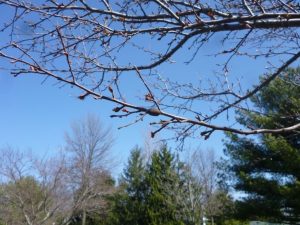
Date: 3/23/16 (No hatch). Do you see it? One inch long Tent Cat egg mass overwinters encircling 2-3 year old twigs. (Photo Credit: Steven K. Rettke, Rutgers Coop. Ext.)

Date: 3/23/16 (No Hatch). Close-up of the Tent Cat egg mass. It has the appearance & feel of styrofoam. (Photo Credit: Steven K. Rettke, Rutgers Coop. Ext.)
The eastern tent caterpillar, Malacosoma americanum spp., is native to North America and found throughout the United States east of the Great Plains, and in the southern part of eastern Canada. This pest is one of the more significant defoliators of deciduous shade trees. Their preferred hosts include isolated, open-grown trees, especially wild cherry, crab apple, and apple. During outbreak years, which frequently occur at 8 to 10-year intervals, this pest will also occasionally attack pecan, hawthorn, beech, willow, and other shade trees.
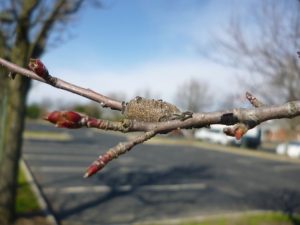
Date: 3/23/16 (Early hatch). Eggs on shady side of tree have yet to hatch. Bright sun at southern side of tree initiates the early 1st hatch. Too early? No leaves to eat! (Photo Credit: Steven K. Rettke, Rutgers Coop. Ext.)

Date: 3/23/16 (PPI). A few hundred yards away from Tent Cat egg hatch, a saucer magnolia & star magnolia are in bloom. (Plant phenological indicators.) (Photo Credit: Steven K. Rettke, Rutgers Coop. Ext.)
Eastern tent caterpillars construct silk nests in the forks of trees, which are easily recognized during the spring months. The noticeable tents/nests cause an exaggeration of their impact as pests. Defoliation by this caterpillar will rarely cause tree mortality, as trees will re-foliate. The reduced aesthetic value of trees in urban & suburban areas is the primary harm created by the activities of this pest. Outbreak years also arouse much concern among area residents when the caterpillars migrate in mass across landscapes in search of new food or a place to complete their development. Nevertheless, unlike the gypsy moth, the eastern tent caterpillar has never been a major threat to the vitality of our forests and rarely reach large populations in ornamental trees.
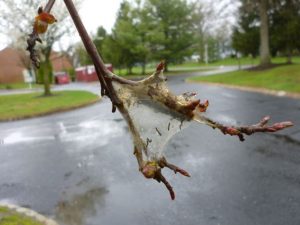
Date: 4/2/16 (Early webbing). Early webbing of Tent Cat forms between the forks of branches. Still many leaf buds have yet to expand. (Photo Credit: Steven K. Rettke, Rutgers Coop. Ext.)
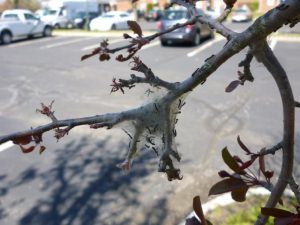
Date: 4/13/16 (Growing tent webbing). Two weeks after initial hatch, all eggs have hatched as there are now more leaves to eat. (Photo Credit: Steven K. Rettke, Rutgers Coop. Ext.)
Tent caterpillars spend the winter in brown masses of 150-350 eggs that the adult female attaches around small outer twigs. These shiny brown bands can be readily recognized and removed by hand. During the late 1800’s and early 1900’s, whole communities mobilized to combat the perceived threat of infestation by the eastern tent caterpillar. For example, in an early eradication campaign in Connecticut in 1913, more than 10 million egg clusters were destroyed when the extension service offered a $25 prize to the school child who collected the most. Such mechanical control efforts still overlooked as many as 20% of the eggs. Therefore, after larvae hatched in the spring and the silk tents formed, prize money was again awarded to school children in numerous towns for the number of tents they collected. In one such town, the children collected nearly 17,000 tents, weighing over half a ton. Then, usually with great vengeance and satisfaction, these tents were torched by flames or viciously stomped upon. Many of these same towns also offered a reward of 10 cents per quart filled with pupal cocoons of this insect. For instance, in 1899, at Glen Falls, NY, 1350 quarts containing the cocoons were turned in.
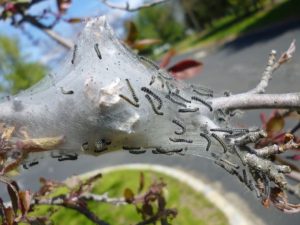
Date: 4/19/16 (Dense webbing). An established Tent Cat population is significantly growing & expanding. Over time the nest will be composed of multiple silk layers. (Photo Credit: Steven K. Rettke, Rutgers Coop. Ext.)
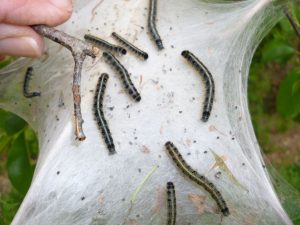
Date: 4/27/16 (Mid-Instars). The white racing stripes are clearly visible on these mid-instar caterpillars. Tent Cats have 6 larval instars. (Photo Credit: Steven K. Rettke, Rutgers Coop. Ext.)
The simple mechanical methods of removing and destroying egg masses, tents, and pupal cases of tent caterpillars were and continue to be environmentally friendly ways of effectively suppressing their numbers in small, localized areas. However, even though these cultural practices should continue to be encouraged where they are practical, their limitations will always be evident.

Date: 5/7/16 (Early morning clustering). During cool early spring mornings, Tent Cats will cluster closely together on top of the nest & warm themselves with the help of the sun. (Photo Credit: Steven K. Rettke, Rutgers Coop. Ext.)
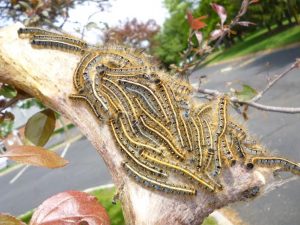
Date: 5/14/16 (Structural coloration). Light reflected at different angles can cause color changes to the Tent Cat that can vary dramatically. (Photo Credit: Steven K. Rettke, Rutgers Coop. Ext.)
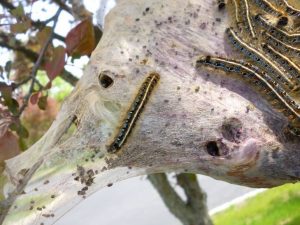
Date: 5/14/16 (Nest openings). Multiple silk layers within the nest webbing requires entrance & exit openings. The openings also provide ventilation cooling to prevent the inner nest from overheating. (Photo Credit: Steven K. Rettke, Rutgers Coop. Ext.)
Disease, natural enemies, and starvation are the primary environmental factors involved in the suppression of tent caterpillar species, which act to curb cyclical outbreaks of this insect. Since they are native caterpillars, numerous predators (i.e., spiders, ants, yellow jackets, assassin bugs, birds) and parasitoids (i.e., braconid wasps, ichneumonid wasps, tachinid flies) attack tent caterpillars, but in some years these beneficials do not arrive in time or in sufficient numbers to adequately control them every season. As a result, the 8 to 10 year intervals between outbreak populations has been a trend.
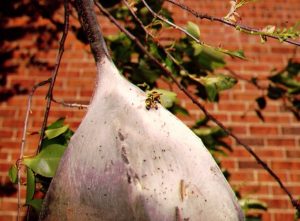
Yellowjacket wasps are excellent caterpillar predators. They will dig & create their own openings into the silk webbing & grab Tent Cats near the surface. (Photo Credit: Steven K. Rettke, Rutgers Coop. Ext.)
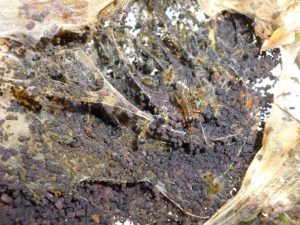
Parasitoids such as this apparent ichneumonid wasp use the Tent Cats as prey. Photo Credit: Steven K. Rettke, Rutgers Coop. Ext.)
During tent caterpillar outbreaks, the higher competition invariably results in lower food quality and greater vulnerability to infection by viral (e.g., NPV), bacterial (Clostridium), and fungal (e.g., Entomophaga) diseases. Pupal parasitism of the caterpillar also increases with outbreaks of long duration. Finally, weather factors often play a key role toward the collapse of tent caterpillar outbreaks. For optimum survival, egg hatch in the spring is synchronized with the development of the leaves on the trees they typically feed upon. Observations have indicated over 99% mortality of tent caterpillars from starvation in regions where unusual weather patterns caused the forestalling of the development of the leaves on the trees.
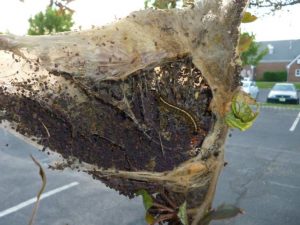
Date: 5/25/16 (Late instar). This final 6th instar caterpillar is among the last to permanently vacant & abandon the frass filled silk nest. (Photo Credit: Steven K. Rettke, Rutgers Coop. Ext.)
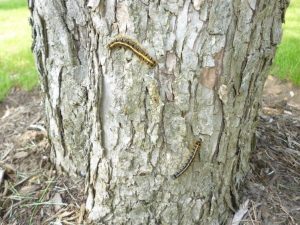
Date: 5/26/16 (Migrating off tree). Late instar caterpillars (2.5 inches in size) migrate off tree in order to search for an area to pupate. (Photo Credit: Steven K. Rettke, Rutgers Coop. Ext.)
Occasionally cultural and biological control strategies will fail to adequately keep their populations in check in specific areas. Environmentally friendly, biorational products such as horticultural oils and insecticidal soaps can suppress young larvae upon direct contact. The bacterium (Bacillus thuringiensis) is the biological insecticide material of choice against young tent caterpillars less than 1-inch in size (i.e., first 3 instars). Acelepryn (chlorantraniliprole) is a reduced risk insecticide & has low negative impacts to beneficial insects. If applied as a spray treatment, it has translaminar properties. Tebufenozide (Confirm) is an insect growth regulator (IGR) & is classified as a reduced risk material by the EPA. Spinosad (Conserve) is OMRI approved & rounds out the list of the more biorational types of insecticides.
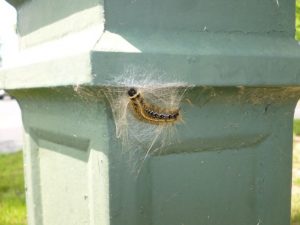
Date: 5/26/16 (Weaving silk to pupate). Finding a secure space to successfully pupate? There are numerous potential predators that are a threat. (Photo Credit: Steven K. Rettke, Rutgers Coop. Ext.)
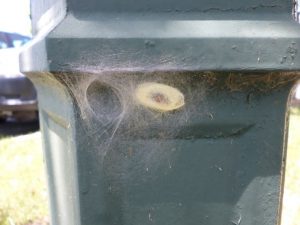
Date: 6/2/16 (50% success rate). A successful pupation on right, but caterpillar on the left was taken by a predator before it could complete the pupation. (Photo Credit: Steven K. Rettke, Rutgers Coop. Ext.)
Do not use flaming torches when attempting to control. Instead, prune or rub out early in the morning/late afternoon or during rainy days when caterpillars are inside the nest. Most caterpillar species are relatively easy to kill with traditional contact insecticides. Penetrate the nest and control with carbaryl (Sevin) or one of the pyrethroids.
However, costly protection efforts to prevent damage to trees are rarely justified. Pesticide treatments may then be used as the option of last resort and then only on trees of high value or in areas having important recreational uses.
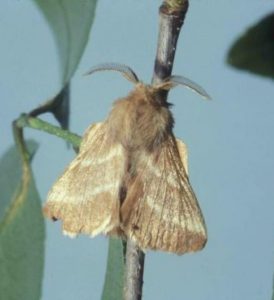
After approximately 2-weeks, the adult Eastern Tent Caterpillar moths emerge from pupation. The strictly nocturnal flying moth will mate & typically lay eggs during late June. The one generation cycle will be complete. (Photo Credit: North Carolina Coop. Ext.)
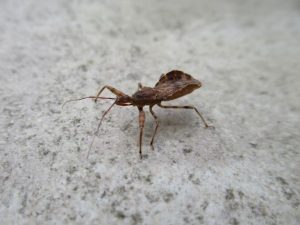
It is possible a predator such as the assassin bug shown above could have taken the Tent Cat as it attempted to pupate. However, a more likely scenario is it was spotted by a bird, shortly after the photo had been taken. Some bird species that have been known to feed on Tent Cats include cardinals, blue jays & orioles. (Photo Credit: Steven K. Rettke, Rutgers Coop. Ext.)
References:
Coulson, R.N. and Witter, J.A., 1984, Forest Entomology – Ecology and Management, Wiley-Inter-science Publications, New York.
Fitzgerald, T.D., 1995, The Tent Caterpillars, Comstock Publishing Associates and Cornell University Press, Ithaca, NY.
Penn State Cooperative Extension, 1991, The Eastern Tent Caterpillar, The Pest Sheet (G.A. Hoover and P.R. Haller, eds), Department of Entomology, Penn State College of Agriculture, University Park, PA.
USDA Forest Service 1990. The Eastern Tent Caterpillar. Maryland Department of Agriculture and USDA Forest Service, US Government Printing Office, Washington, DC.

